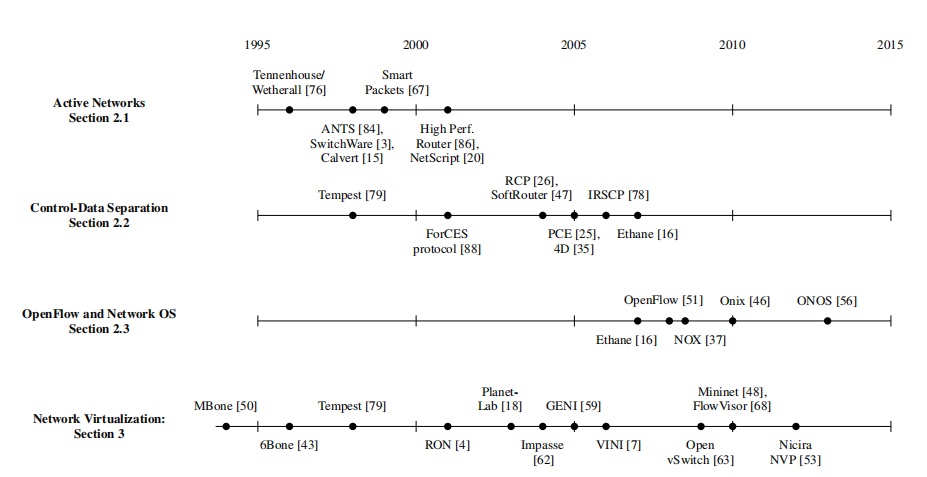2019 SDN课程阅读作业(2)
阅读文章《The Road to SDN: An Intellectual History of Programmable Networks》,并根据所阅读的文章,书写一篇博客,回答以下两个问题:
1.过去20年中可编程网络的发展可以分为几个阶段?每个阶段的贡献是什么?

Making computer networks more programmable enables innovation in network management and lowers the barrier to deploying new services. In this section, we review early work on programmable networks. We divide the history into three stages, as shown in Figure 1. Each stage has its own contributions to the history:
(1) active networks (from the mid-1990s to the early 2000s), which introduced programmable functions in the network to enable greater to innovation;
(2) control and data plane separation (from around 2001 to 2007), which developed open interfaces between the control and data planes;
(3) the OpenFlow API and network operating systems (from 2007 to around 2010), which represented the fifirst instance of widespread adoption of an open interface and developed ways to make control-data plane separation scalable and practical;
(4)Network virtualization played an important role throughout the historical evolution of SDN, substantially predating SDN yet taking root as one of the fifirst significant use cases for SDN. We discuss network virtualization and its relationship to SDN in Section 3.
2.网络虚拟化与SDN的关系?
Relationship of Network Virtualization to SDN. Network virtualization (an abstraction of the physical network in terms of a logical network) clearly does not require SDN. Similarly, SDN (the separation of a logically centralized control plane from the underlying data plane)does not imply net work virtualization. Interestingly, however, a symbiosis between network virtualization and SDN has emerged, which has begun to catalyze several new research areas. SDN and network virtuali zation relate in three main ways:
-
SDN as an enabling technology for network virtualization. Cloud computing brought network virtualization to prominence, because cloud providers need a way to allow multiple customers (or“tenants") to share the same network infrastructure. Nicira's Network Virtualization Platform (NVP) offers this abstraction without requiring any support from the underlying networking hardware. The solution is use overlay networking to provide each tenant with the abstraction of a single switch connecting all of its virtual machines. Yet, in contrast to previous work on overlay networks, each overlay node is a actually an extension of the physical network- -a software switch (like Open vSwitch ) that encapsulates traffic destined to virtual machines running on other servers. A logically centralized controller installs the rules in these virtual switches to control how packets are encapsulated, and updates these rules when virtual machines move to new locations.
-
Network virtualization for evaluating and testing SDNs.The ability to decouple an SDN control application from the underlying data plane makes it possible to test and evaluate S DN control applications in a virtual environment before the application is deployed on an operational network. Mininet uses process-based virtualization to run multiple virtual OpenFlow switches,end hosts, and SDN controllers- each as a single process on the same physical (or virtual) machine. The use of process-based virtualization allows Mininet to emulate a network with hundreds of hosts and switches on a single machine. In such an environment, a researcher or network operator can develop control logic and easily test it on a full-scale emulation of the production data plane; once the control plane has been evaluated, tested,and debugged, it can then be deployed on the real production network.
-
Virtualizing (“slicing”) an SDN. In conventional networks, virtualizing a router or switch is complicated,because each virtual component needs to run own instance of control-plane software. In contrast, virtualizing a“dumb”SDN switch is much simpler. The FlowVisor system enables a campus to support a testbed for networking research on top of the same physical equipment that carries the production traffic. The main idea is to divide traffic flow space into“slices" (a concept introduced in earlier work on PlanetL ,ab), where each slice has a share of network resources and is managed by a different SDN controller. FlowVisor runs as a hypervisor, speaking OpenFlow to each of the SDN controllers and to the underlying switches. Recent work has proposed slicing control of home networks, to allow different third-party service providers (e.g, smart grid operators) to deploy services on the network without having to install their own infrastructure. More recent work proposes ways to present each“slice” of a software-defined network with its own logical topology and address space.


 浙公网安备 33010602011771号
浙公网安备 33010602011771号